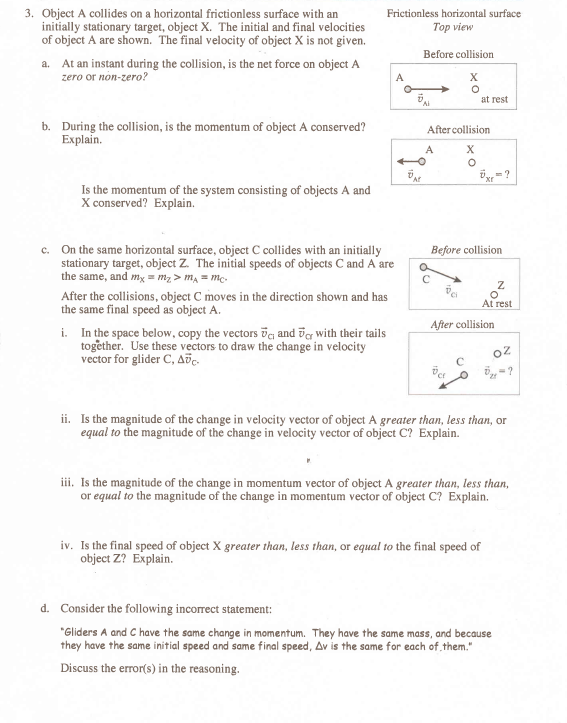Object A collides on a horizontal frictionless surface with an initially stationary target, object X. The initial and final velocities of object A are shown. The final velocity of object X is not given.
a). At an instant during the collision, is the net force on object A zero or non-zero?
b) [During the collision, is the momentum of object A conserved? Explain. Is the momentum of the system consisting of objects A and X conserved? Explain. On the same horizontal surface, object C collides with an initially stationary target, object Z. The initial speeds of objects C and A are the same, and m_x = m_z > m_A = m_c. After the collisions, object C moves in the direction shown and has the same final speed as object A. In the space below, copy the vectors v_C1 and v_cr with their tails together. Use these vectors to draw the change in velocity vector for glider C, Delta v_c. Is the magnitude of the change in velocity vector of object A greater than, less than, or equal to the magnitude of the change in velocity vector of object C? Explain? Is the magnitude of the change in the momentum vector of object A greater than, less than, or equal to the magnitude of the change in the momentum vector of object C? Explain? Is the final speed of object X greater than, less than, or equal to the final speed of object Z? Explain. Consider the following incorrect statement: Gliders A and C have some change in momentum. They have the same mass, and because they have the same initial speed and same final speed. Delta-v is the same for each of.them." Discuss the error(s) in the reasoning.

Object A collides on a horizontal frictionless surface with an initially stationary target, object X. The initial and final velocities of object A are shown. The final velocity of object X is not given.
a). At an instant during the collision, is the net force on object A zero or non-zero?
b) [During the collision, is the momentum of object A conserved? Explain. Is the momentum of the system consisting of objects A and X conserved? Explain. On the same horizontal surface, object C collides with an initially stationary target, object Z. The initial speeds of objects C and A are the same, and m_x = m_z > m_A = m_c. After the collisions, object C moves in the direction shown and has the same final speed as object A. In the space below, copy the vectors v_C1 and v_cr with their tails together. Use these vectors to draw the change in velocity vector for glider C, Delta v_c. Is the magnitude of the change in velocity vector of object A greater than, less than, or equal to the magnitude of the change in velocity vector of object C? Explain? Is the magnitude of the change in the momentum vector of object A greater than, less than, or equal to the magnitude of the change in the momentum vector of object C? Explain? Is the final speed of object X greater than, less than, or equal to the final speed of object Z? Explain. Consider the following incorrect statement: Gliders A and C have some change in momentum. They have the same mass, and because they have the same initial speed and same final speed. Delta-v is the same for each of.them." Discuss the error(s) in the reasoning.
